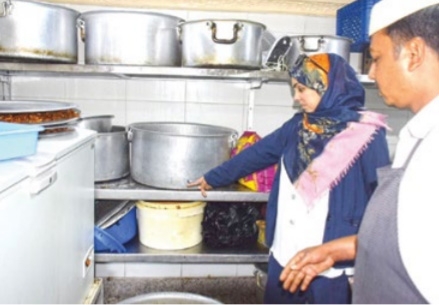MoH steps up inspection campaign on food outlets
Health Ministry vows strict action against violators
As part of the Health Ministry’s efforts to promote public health, the Food Control Department within the Ministry of Health has carried out inspection campaigns across restaurants and food outlets in Muharraq, Northern and Capital Governorates.
The ministry has stressed that inspection campaigns will be intensified to ensure that all safety rules are followed at food outlets and restaurants in the greater interest of the public.
The team has notified violations to food outlet owners while instructing them to adhere to established standards regarding food preparation and serving. The team also directed all restaurant staff to follow personal hygiene requirements. For her part, Dr Najat AbulFateh, Director of Public Health, stressed the importance of these campaigns, pointing out that the inspection campaigns aim to ensure the quality of food consumed by the public.
Dr Najat praised the community’s role in monitoring and reporting to the Ministry of Health about any food safety violations, and called on citizens and residents of the Kingdom of Bahrain to co-operate with health inspectors to eliminate violations and contribute to restaurants and food supply compliance with health requirements.
According to experts, one of the key requirements for preparing and storing safe food is to have procedures based on the principles of HACCP (Hazard Analysis and Critical Control Points). Although this was first developed for the food processing industry, even small food handlers such as individual restaurants, bars and cafes should have procedures based on HACCP. In some countries, it is also a legal requirement.
HACCP is a systematic approach to identifying, evaluating, and controlling food safety hazards, and is based around seven basic principles. The FDA recommends using the Process Approach to HACCP for the retail and hospitality sectors to take account of the increased complexity of food preparation in restaurants. The Process Approach divides the food flows into broad categories based on the stages in the preparation of food, analysing the hazards and placing controls on each grouping.
Identifying and controlling the hazards in each process achieves the same control of risk factors as making a HACCP plan for each product, according to the FDA and so achieves the same level of safety. Premises include the buildings and rooms involved in food preparation and storage. They must be kept clean and in good condition and the design must provide suitable space for working and maintaining hygienic practices, prevent the build-up of dirt and mould, and provide suitable conditions for handling and storage of food.
The premises should provide adequate: Hand washing facilities and toilets for staff, ventilation in kitchens and toilets, lighting, drainage for kitchens and toilets, facilities for staff to change clothes and storage of cleaning chemicals, disinfectants and other chemicals.
Staff working in food handling areas must keep good personal hygiene and be aware of practices and factors that can cause contamination of food and cross contamination. All raw materials and ingredients used and any material used in processing products must be safe and not contaminated with anything that would make the final product unfit for human consumption.
Storage, processing and distribution systems must protect food from contamination and cross-contamination that makes it harmful to health or makes it become unfit to be eaten. This includes pest control and having processes and procedures that limit bacterial levels to within specified criteria.
Related Posts

